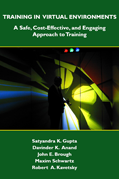Training in Virtual Environments
A Safe, Cost-Effective, and Engaging Approach to Training
S.K. Gupta, D.K. Anand, J. Brough, M. Schwartz, and R. Kavetsky
ISBN: 978-0-9777295-2-4
CALCE EPSC Press, University of Maryland, College Park, MD, 2008
 |
The Center for Energetic Concepts Development at the University Maryland, College Park and the Energetics Technology Center in La Plata, Maryland are working on developing methodologies for training in virtual environments.This book reports on the work and provides an overview of different components of virtual environments. The technologies covered include displays, tracking systems, and user interaction devices. It also provides an overview of the basic modeling framework for creating objects in the virtual environment and manipulating them. This material is expected to help the reader understand different technology choices in constructing virtual environments and their advantages and disadvantages in training applications. For more information, contact Ania Picard at picard@cecd.umd.edu. |
Contents
Chapter 1 Introduction
1.1 Definitions
1.2 Brief History of Virtual Environments
1.3 Components of Virtual Environments
1.4 Next Generation Training Needs
1.5 Role of Virtual Environments in Training
1.6 Structure of the Book
Chapter 2 Overview of Display Technologies
2.1 Benefits of Depth Perception in Training
2.2 Principles of Stereo Vision
2.3 Head Mounted Displays
2.4 Projection-Based Stereo Displays
Chapter 3 Interacting with Virtual Environments
3.1 Tracking Technologies
3.2 Touching and Feeling Virtual Objects
Chapter 4 Geometric Modeling for Virtual Environments
4.1 Representing Geometric Objects
4.2 Geometric Transformations
4.3 Trajectory Specifications
4.4 Rendering
4.5 Collision Detection
Chapter 5 Use of Virtual Environments in Training Applications
5.1 Virtual Environment-Based Training Tools
5.2 Transfer of Knowledge
5.3 Effects of Presence, Memory, and Spatial Abilities on Learning
5.4 Assembly Design and Planning in Virtual Environments
5.5 Development of Intelligent Tutoring Systems for Training
Applications
Chapter 6 Virtual Training Studio
6.1 Background
6.2 Hardware
6.3 Software Architecture
6.4 Benefits of VTS
Chapter 7 Virtual Author
7.1 Background
7.2 Training Material Creation Process
7.3 Technical Challenges and Solutions
7.4 Discussion
Chapter 8 Virtual Mentor
8.1 Background
8.2 Handling of Symmetries and Error Detection
8.3 Annotation of Ambiguous Instructions
8.4 Logging, Analysis, and Generation of Custom Tests
8.5 Discussion
Chapter 9 Assessment of the VTS and Training Performance
9.1 Background
9.2 Methodology
9.3 Data Analysis: System Performance
9.4 Data Analysis: Training Modes
9.5 Data Analysis –Training Features
9.6 Learning Paths
9.7 Survey Results
9.8 Estimating Training Time
9.9 Future Tutorial Development Analysis
9.10 Main Findings
Chapter 10 Emerging Technologies
10.1 Stereo Displays without Glasses
10.2 Improved User Interfaces
10.3 Ease of Creating 3D Models
10.4 Mixed Reality
10.5 Models for Virtual Humans
10.6 Context Dependent Simplifications
10.7 Capturing Cognitive Activities during Complex Training Tasks
10.8 Incorporating Annotations in 3D Animations
10.9 Automatically Adjusting the Level of Detail in Instructions

